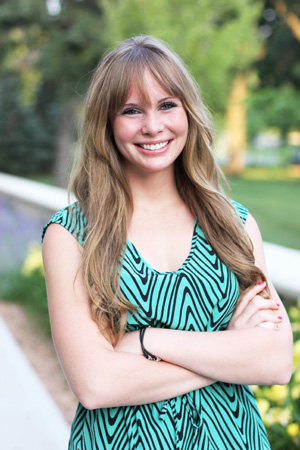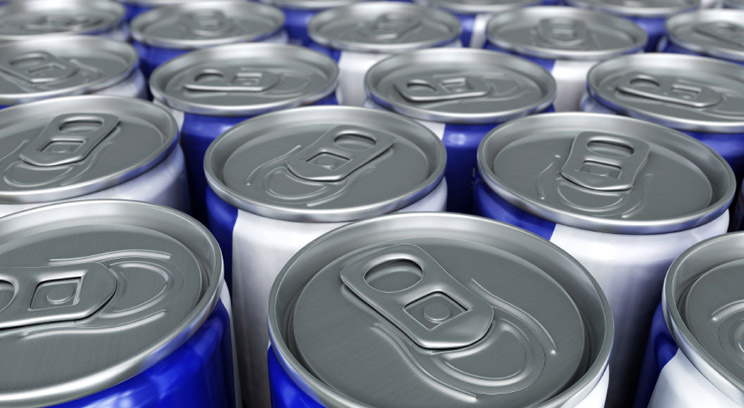It's a common phrase uttered by college students every day. "I'm so tired."
For many, temporary relief from fatigue can be found in the convenient and readily available array of energy drinks. According to the Journal of the American Medical Association, 6 billion energy drinks were consumed in 2010 in the U.S. But are they the safest option for re-energizing?

Caitlin Kelly
UST senior and neuroscience major Caitlin Kelly doesn't think so. She recently completed a study on energy drink usage and its relation to risk taking among college students. What she found was compelling.
She first became interested in the topic of energy drink usage as a sophomore in Dr. Roxanne Prichard's drugs, alcohol and behavior course. For a class paper on ethical issues, Kelly chose to write about how there is no age limit for buying energy drinks. "A five-year-old could just go and buy six energy shots," she said. It's a troubling notion considering how what little information manufacturers of the drinks are required to provide.
In her research, she discovered that the FDA considers energy drinks dietary supplements rather than beverages, which means manufacturers of energy drinks are not subject to the same regulations as beverage makers. "They don't even have to list caffeine amounts on the package," Kelly said, noting that the amount of caffeine in an energy drink can often be twice to three times as much as what is found in a caffeinated soda.
As she continued her research, Kelly read about a survey of people who had mixed energy drinks with alcohol. "There was a field study where people were surveyed coming out of a bar," she said. "They found that people who had mixed alcohol with energy drinks were three times more likely to have a blood alcohol level higher than .08 and also were four times more likely to drive while intoxicated."
The statistics are startling when you consider energy drink culture among college students, according to Kelly. "Since many people are unaware of the caffeine content, the combination of energy drinks and alcohol has be come especially popular – and dangerous – among college students," her research notes. "Out of 647 college students who reported drinking alcohol in a 30-day period, 24 percent of them mixed alcohol with an energy drink."
Kelly began to wonder about the connection between energy drinks and risk taking. Do the highly caffeinated concoctions actually cause people to throw caution to the wind? She designed a lab study to find out.
"I was sure that my first study would conclude that the drinks were causing people to take more risks," she said. "But I didn't find that to be the case at all." Frustrated, she worried that the time spent on her first study was wasted. But for a burgeoning researcher it was a lesson learned. "That is so not what the research process is about," she said, acknowledging that although she didn't initially discover what she was looking for, the opportunity for more research on the topic arose.
For her second study, Kelly conducted an online survey of UST students, which revealed that even though the drinks themselves weren't causing students to engage in risky behavior, there still was a correlation with living on the edge. "The population of students we found are more likely to push things to the limit," she said. She found that those who consumed more than three a month were more likely to forgo simple, everyday precautions like wearing a seat belt. They also were more likely to drive drunk.
She also found a correlation between mental illness and energy drink usage. Her results showed that students with preexisting medical conditions such as insomnia, ADHD, depression, anxiety and anorexia are more likely to be high energy drink users compared to the general student population. "It was interesting to find out that, of the people with mental illness, those with eating disorders were most likely to use energy drinks," she said. "Now there are sugar-free options with barely any calories that can give someone enough caffeine to sustain themselves if they haven't eaten all day."
Kelly's findings are significant as she continues to work with Prichard, whose primary research area is sleep. "From when I had her in class as a sophomore, Caitlin stood out as someone who is very motivated and competent," Prichard said.
In June 2013, Prichard brought Kelly to the American College Health Association conference in Boston. Kelly was among a small group of undergraduate students at the conference, which was attended mostly by physicians, professors, college administrators and pharmacists. The two copresented the energy drink research. "It's really rare to be comfortable enough with a student to put them in front of a group like that," Prichard said.
Kelly's collaboration with Prichard led to additional opportunities as well. In 2014, Kelly began working at the Wellness Center as its first sleep specialist, a role in which she was able to immediately implement what she had learned as Prichard's research assistant. In April, she coordinated UST's first Sleep Week, which promoted the importance of sleep and offered suggestions for healthier alternatives to consuming energy drinks and other caffeinated beverages.
While Kelly continues to be an advocate for healthy alternatives for staying alert, she has concluded that more research needs to be done to fill the knowledge gaps in energy drink usage and risk taking. "It's more dangerous than people understand," she said.
As for herself, Kelly doesn't plan to consume energy drinks. "I definitely take more natural approaches now if I'm feeling tired," she said.
After graduation, Kelly plans to work as a researcher at Abbott Northwestern Hospital before considering her options for grad school. She hopes to continue doing research in health and wellness throughout her career.
Kelly's research was funded by a Young Scholars Grant and a Student Travel Grant through the Grants and Research Office.







